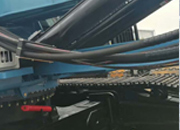How to Choosing a Chemical Hose
2022-08-04 15:32:26
Chemical Hoses are versatile enough to handle the many types of industrial chemicals currently used. Chemical Delivery Hoses can be used for suction, gravity flow, and pressure service. Chemical Hoses can be cleaned using open-end steam or Sodium Hydroxide at 212degF. This article will discuss some of the features of chemical hoses, their advantages, and their application. We hope this article has provided you with an understanding of this important industrial hose.
Chemical hose
The safety data sheet is crucial when choosing the right chemicalhose. It identifies the risk of static charges and operates safely in zones determined to be explosive. The chemical resistance table is available for download as an attachment. When selecting a chemical hose for your specific application, you should check the safety data sheet for any recommended precautions. Listed below are some tips to choosing a chemical hose. These are other tips:
First, ensure that the hose has the correct temperature rating. Chemical hose with a temperature rating of 104degF or less is recommended for corrosive or acidic liquids. Its EPDM cover is abrasion-resistant and the white spiral stripe makes it easy to identify. Chemical hoses are suitable for both gravity flow and pressure applications. However, they should be chosen based on temperature. Chemical hoses that are made of flexible materials are also available in long lengths.
Protective gear is another tip for cleaning chemical-hoses. Because chemicals can corrode and damage plastic and other materials, it's crucial that chemical hoses be cleaned properly. It is important to use a cleaning solution that is compatible for the hose fittings and lining. Listed below are some tips to use the chemical hose cleaning solution. While cleaning, you should keep in mind that you should always wear gloves, goggles and protective clothing.
Material conveying hose
Material conveying hose refers to a flexible hose that can be used to transport liquids and solids. It can be made from different materials to suit a variety applications. Metal hoses can be used in high-pressure and suction systems, and are suitable for conveying food and drinks. Other common materials used in material conveying hoses are water and air. Some material conveying hoses can also be used for conveying high-pressure gases and air.
A material conveying hose is made up of a feeding end 202, a feeding portion 201, and a discharging end 203. The feeding end 202 connects to the feed device for inputting the materials, while the feeding part 201 deforms the hose by exerting an extrusion force. The materials are then conveyed through the hose, while the discharge end 203 is used to quantitatively supply the materials to downstream devices.
A material conveying hose can be used for many purposes. It can be used to load and unload silo containers, as well as transport silo tanks and silo vehicles. Antistatic hoses can be used to unload silos and other equipment made from granular materials. Other uses include conveying granulates and vacuum conveyors, shredders and extruders.
Chemical Delivery Hose
Chemical Delivery Hose is required for liquid chemicals transportation. It is made from polyethylene and can transport more than 90% all known chemicals. These hoses are safe for both personnel and chemicals. They can be used to move chemical mixtures from tanks to trucks. Here are some tips to help you choose the right chemical hose for your application. Read the safety data sheets carefully to ensure the best product. You can also consult chemical resistance tables to find out which material is best for your specific needs.
The OE Acid/Chemical Delivery Hose by Guyson is an excellent choice for the transfer of chemicals and is available for most chemical applications. These suppliers provide chemical delivery hoses that are extremely resistant to chemicals and are specifically designed for specific applications and working conditions. They are also more durable than other chemical delivery hoses and have a better seal. If you're using chemical hoses in your process, be sure to verify the specifications before purchasing.
The material used to manufacture Chemical Delivery Hose is made of smooth polyethylene, antistatic rubber compound, EPDM rubber, and steel spirals. The chemical delivery hose's inner tube is made of high molecular weight cross-linked polyethylene, which will not leech into the conveyed product. This hose is safe and economical for chemical processes. You will never worry about chemical leaking from your Chemical Delivery Hose again after you have purchased it!